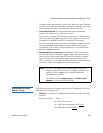
Event Handles for fsm.exe on a Windows Metadata Server
StorNext User’s Guide 335
Event Handles for fsm.exe on a Windows Metadata Server
The metadata server (FSM) has many data structures that are used
internally. Each of the data structures has some locks
(pthread_mutex_lock). Each lock is initialized as “uninitialized.”
The first time the lock is used, a small amount of memory and an event
(i.e., handle) are allocated. The memory and event/handle are retained
by the system until the data structure is destroyed. Some locks that are
part of structures are seldom used, and exist for rare conditions. If the
lock is not used, the memory/event for that structure will never be
allocated.
Some data structures are not destroyed during the life of the FSM. These
include in-memory inodes and buffers and others.
When the system starts, handle use is minimal. After the FSM has been
up for a while, the handle count increases as the inode and buffer cache
are used. After a while, the system stabilizes at some number of handles.
This occurs after all inodes and buffers have been used.
The maximum number of used handles can be reduced by shrinking the
inode and/or buffer cache. However, changing these variables could
significantly reduce system performance.
FSBlockSize, Metadata Disk Size, and JournalSize
Settings
The FsBlockSize (FSB), metadata disk size, and JournalSize settings all
work together. For example, the FsBlockSize must be set correctly in
order for the metadata sizing to be correct. JournalSize is also dependent
on the FsBlockSize.
For FsBlockSize the optimal settings for both performance and space
utilization are in the range of 16K or 64K.
Settings greater than 64K are not recommended because performance
will be adversely impacted due to inefficient metadata I/O operations.


















